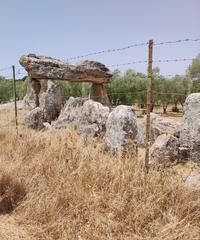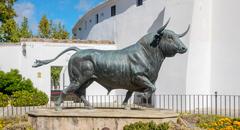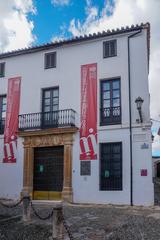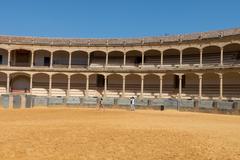Ermita Rupestre de La Oscuridad, Ronda, Spain: Visiting Hours, Tickets, and Comprehensive Travel Guide
Date: 14/06/2025
Introduction
The Ermita Rupestre de La Oscuridad in Ronda, Spain, stands as one of Andalusia’s most evocative and unique historical sites. Carved directly into ancient limestone cliffs within Ronda’s urban core, this rock-cut hermitage is a rare survivor from the early medieval period. It provides a tangible connection to centuries of Christian monastic life, resilience, and adaptation, particularly during the complex Visigothic era and the time of Mozarabic Christian communities living under Islamic rule. This guide offers a detailed exploration of the site’s history, architecture, cultural significance, visiting hours, ticketing, accessibility, and nearby attractions to enhance your experience of this hidden gem (Origenes de Europa, Diario Sur, Andalucia.com).
Table of Contents
- Introduction
- Historical Background
- Architectural Features and Layout
- Archaeological and Cultural Significance
- Visiting the Ermita Rupestre de La Oscuridad
- Nearby Attractions
- Preservation and Research
- Frequently Asked Questions (FAQ)
- Summary and Final Tips
- References
Historical Background
Origins and Early Development
Dating from the 8th–10th centuries CE, the Ermita Rupestre de La Oscuridad was established in a period of profound transition on the Iberian Peninsula. Initially shaped by Visigothic Christian traditions, it later became a sanctuary for Mozarabic Christians—those who maintained their faith under Muslim rule after the conquest of 711 CE (Origenes de Europa). Its discreet, carved setting illustrates the adaptive strategies of minority religious communities seeking solitude and safety during periods of political change.
Historical Context
The hermitage’s use by Mozarabic Christians during Islamic governance highlights the region’s history of religious coexistence and tension. The site provided a vital refuge for worship and burial practices that were otherwise restricted in public life, underscoring its importance as a center of spiritual resilience (Diario Sur).
Architectural Features and Layout
Rock-Cut Construction
The Ermita Rupestre de La Oscuridad is hewn directly from limestone formed some 65 million years ago. This labor-intensive method offered natural insulation, protection, and a harmonious integration with the landscape. The hermitage features a main sanctuary chamber, additional monastic cells, and a necropolis, all carved with remarkable skill (Andalucia.com).
Interior Layout
- Main Chamber: Measuring approximately 10 by 8 meters, the central hall served as the sanctuary, with interior apses and liturgical niches.
- Residential Quarters: Adjacent rooms provided living space for a cenobitic (communal) monastic community.
- Storage Areas: Evidence of storage spaces for food and livestock highlights the self-sufficiency of its early inhabitants (aunclicdelaaventura.com).
Necropolis and Burial Practices
The necropolis is notable for its elongated, rock-cut niches, serving as tombs for members of the community. This dual function as a place of worship and burial emphasizes the hermitage’s role as both a spiritual and memorial center (Andalucia.com).
Archaeological and Cultural Significance
Funerary and Memorial Role
The presence of burial niches carved into the rock makes the site a rare example of early medieval funerary architecture in urban Andalusia. These tombs, reserved for the hermitage’s inhabitants, underscore the continuity of Christian burial traditions during periods of political upheaval (Origenes de Europa).
Religious Syncretism and Adaptation
The hermitage is a testament to the syncretic blend of Visigothic, Mozarabic, and Andalusian traditions. Its discreet architecture and continued use through centuries, including later secular functions such as a tannery, reflect the layered adaptations of the site (ermitadelaoscuridad.com).
Visiting the Ermita Rupestre de La Oscuridad
Visiting Hours and Tickets
- Opening Hours: Visits are strictly by appointment, ensuring preservation and an intimate visitor experience (ermitadelaoscuridad.com).
- Special Openings: The site is occasionally open to the public during events such as World Tourism Day and local cultural celebrations. Always check the official website or contact the Ronda Tourism Office for the latest updates (Ronda Tourism Office).
- Admission: General entrance is free, but donations for site preservation are encouraged. Guided tours may have an associated fee.
Booking and Guided Tours
- How to Book: Reserve your visit through the official website or by phone at (+34) 951 083 324.
- Guided Tours: Expert-led tours are available by prior arrangement, providing historical and architectural context.
Accessibility
- Mobility: Due to its historic and rock-cut nature, the hermitage is not wheelchair accessible and involves uneven terrain and narrow passages. Visitors are advised to wear comfortable footwear and be prepared for some physical exertion (ermitadelaoscuridad.com).
- Contact: Visitors with special needs should contact the site in advance to discuss possible accommodations.
Getting There
- Location: Plaza de la Oscuridad, Ronda, Málaga, Spain.
- Directions: The site is within a private courtyard in Ronda’s city center, accessible by a short walk from major attractions like the Puente Nuevo. Limited parking is available nearby.
Photography and Visitor Guidelines
- Photography: Non-flash photography is generally permitted, but always confirm with your guide before capturing images to protect the site.
- Visitor Conduct: Please respect all signage, refrain from touching fragile features, and do not remove any artifacts.
Nearby Attractions
Enhance your visit by exploring other notable sites in Ronda:
- Puente Nuevo: The iconic bridge spanning the Tajo Gorge.
- Baños Árabes (Arab Baths): Well-preserved medieval baths.
- Plaza de Toros: One of Spain’s oldest bullrings.
- Casa del Rey Moro: Historic palace with gardens and a secret mine.
- Virgen de la Cabeza Hermitage: Another significant cave hermitage in the region (aunclicdelaaventura.com).
Preservation and Research
Ongoing restoration, led by the Ponce de León family and supported by local authorities, has stabilized the hermitage and opened it for public appreciation. Archaeological studies continue to uncover details of its monastic life and burial practices, underscoring its candidacy as a Bien de Interés Cultural (Asset of Cultural Interest) (ermitadelaoscuridad.com; Origenes de Europa).
Frequently Asked Questions (FAQ)
Q: What are the visiting hours?
A: Visits are by appointment only. Check the official website or contact the Ronda Tourism Office for the latest schedule.
Q: Is there an entrance fee?
A: Admission is generally free; donations are welcomed. Guided tours may have a fee.
Q: Are guided tours available?
A: Yes, by prior arrangement.
Q: Is the site wheelchair accessible?
A: No, due to its historic, rocky structure, accessibility is limited.
Q: Can I take photographs?
A: Non-flash photography is permitted in most cases, but confirm with your guide.
Summary and Final Tips
The Ermita Rupestre de La Oscuridad is a singular destination for travelers interested in the intersection of history, architecture, and spirituality. Its rock-hewn spaces, burial niches, and centuries-old frescoes offer a meditative retreat and a window into Andalusia’s diverse medieval heritage. Remember to:
- Book your visit in advance.
- Wear sturdy shoes.
- Respect conservation rules during your tour.
- Combine your visit with other historical sites in Ronda for a richer experience.
For guided tours and up-to-date visiting information, consult the official resources or the Ronda Tourism Office. Consider downloading the Audiala app for digital tours and cultural insights.
References
- Origenes de Europa
- Diario Sur
- Andalucia.com
- Ermita de la Oscuridad Official Website
- Ronda Tourism Office
- A un clic de la aventura



